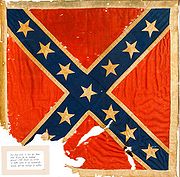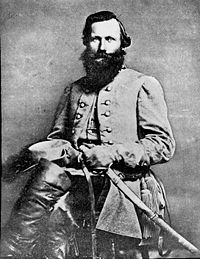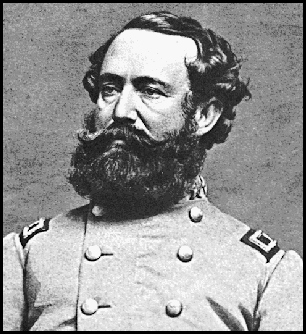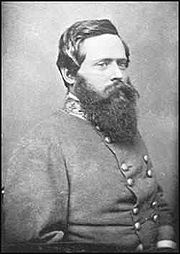
Cavalry Corps, Army of Northern Virginia
Encyclopedia

Army of Northern Virginia
The Army of Northern Virginia was the primary military force of the Confederate States of America in the Eastern Theater of the American Civil War, as well as the primary command structure of the Department of Northern Virginia. It was most often arrayed against the Union Army of the Potomac...
was the only organized cavalry
Cavalry
Cavalry or horsemen were soldiers or warriors who fought mounted on horseback. Cavalry were historically the third oldest and the most mobile of the combat arms...
corps
Corps
A corps is either a large formation, or an administrative grouping of troops within an armed force with a common function such as Artillery or Signals representing an arm of service...
in the Confederate Army
Confederate States Army
The Confederate States Army was the army of the Confederate States of America while the Confederacy existed during the American Civil War. On February 8, 1861, delegates from the seven Deep South states which had already declared their secession from the United States of America adopted the...
during the American Civil War
American Civil War
The American Civil War was a civil war fought in the United States of America. In response to the election of Abraham Lincoln as President of the United States, 11 southern slave states declared their secession from the United States and formed the Confederate States of America ; the other 25...
. Prior to the establishment of a formal corps, cavalry organization in the Confederacy consisted mostly of partisan
Partisan (military)
A partisan is a member of an irregular military force formed to oppose control of an area by a foreign power or by an army of occupation by some kind of insurgent activity...
ranger units and some battalions, a few of which were loosely organized into regiment
Regiment
A regiment is a major tactical military unit, composed of variable numbers of batteries, squadrons or battalions, commanded by a colonel or lieutenant colonel...
s, such as Brig. Gen.
Brigadier General
Brigadier general is a senior rank in the armed forces. It is the lowest ranking general officer in some countries, usually sitting between the ranks of colonel and major general. When appointed to a field command, a brigadier general is typically in command of a brigade consisting of around 4,000...
Turner Ashby
Turner Ashby
Turner Ashby, Jr. was a Confederate cavalry commander in the American Civil War. He had achieved prominence as Thomas J. "Stonewall" Jackson's cavalry commander, in the grade of colonel, in the Shenandoah Valley before he was killed in battle in 1862...
's regiment, and Colonel
Colonel
Colonel , abbreviated Col or COL, is a military rank of a senior commissioned officer. It or a corresponding rank exists in most armies and in many air forces; the naval equivalent rank is generally "Captain". It is also used in some police forces and other paramilitary rank structures...
J.E.B. Stuart
J.E.B. Stuart
James Ewell Brown "Jeb" Stuart was a U.S. Army officer from Virginia and a Confederate States Army general during the American Civil War. He was known to his friends as "Jeb", from the initials of his given names. Stuart was a cavalry commander known for his mastery of reconnaissance and the use...
's 1st Virginia Cavalry Regiment
1st Virginia Cavalry
The 1st Virginia Volunteer Cavalry Regiment was a cavalry regiment raised in Virginia for service in the Confederate States Army during the American Civil War...
.
Background
The source and essence of the Cavalry Corps lay in the background of the age of the Virginia CavaliersVirginia Cavaliers (historical)
Virginia Cavaliers were royalist supporters in the royal colony of Virginia at various times during the colonial period of the United States.-Historical background :...
, the royal families of the Colony of Virginia
Colony and Dominion of Virginia
The Colony of Virginia was the English colony in North America that existed briefly during the 16th century, and then continuously from 1607 until the American Revolution...
who brought the breeding of horses and horsemanship
Equestrianism
Equestrianism more often known as riding, horseback riding or horse riding refers to the skill of riding, driving, or vaulting with horses...
to the colony. Fine horsemanship was an ingrained part of Virginia culture and history, and many Virginians were raised riding and breeding horses
Horse breeding
Horse breeding is reproduction in horses, and particularly the human-directed process of selective breeding of animals, particularly purebred horses of a given breed. Planned matings can be used to produce specifically desired characteristics in domesticated horses...
, and thus were capable of jumping and military skills on the horse that were unequaled by Union cavalry during the war.
Command under Maj. Gen. J.E.B. Stuart

Major General
Major general or major-general is a military rank used in many countries. It is derived from the older rank of sergeant major general. A major general is a high-ranking officer, normally subordinate to the rank of lieutenant general and senior to the ranks of brigadier and brigadier general...
J.E.B. Stuart
J.E.B. Stuart
James Ewell Brown "Jeb" Stuart was a U.S. Army officer from Virginia and a Confederate States Army general during the American Civil War. He was known to his friends as "Jeb", from the initials of his given names. Stuart was a cavalry commander known for his mastery of reconnaissance and the use...
, and was formally established on August 17, 1862. Stuart's command increased in size as part of the history of the Cavalry Corps, as he commanded a brigade
Brigade
A brigade is a major tactical military formation that is typically composed of two to five battalions, plus supporting elements depending on the era and nationality of a given army and could be perceived as an enlarged/reinforced regiment...
, and then a division
Division (military)
A division is a large military unit or formation usually consisting of between 10,000 and 20,000 soldiers. In most armies, a division is composed of several regiments or brigades, and in turn several divisions typically make up a corps...
of cavalry, which finally grew in size to a complete corps. Key engagements of the Cavalry Division/Corps under Stuart's leadership included:
- The Raid around McClellan's army (Peninsula CampaignPeninsula CampaignThe Peninsula Campaign of the American Civil War was a major Union operation launched in southeastern Virginia from March through July 1862, the first large-scale offensive in the Eastern Theater. The operation, commanded by Maj. Gen. George B...
) - The Raid on General PopeJohn Pope (military officer)John Pope was a career United States Army officer and Union general in the American Civil War. He had a brief but successful career in the Western Theater, but he is best known for his defeat at the Second Battle of Bull Run in the East.Pope was a graduate of the United States Military Academy in...
(First Battle of Rappahannock StationBattle of Rappahannock Station I-External links:**...
) - Defense of Crampton's Gap (Maryland CampaignMaryland CampaignThe Maryland Campaign, or the Antietam Campaign is widely considered one of the major turning points of the American Civil War. Confederate Gen. Robert E. Lee's first invasion of the North was repulsed by Maj. Gen. George B...
) - The Raid around McClellan's army (following the Battle of AntietamBattle of AntietamThe Battle of Antietam , fought on September 17, 1862, near Sharpsburg, Maryland, and Antietam Creek, as part of the Maryland Campaign, was the first major battle in the American Civil War to take place on Northern soil. It was the bloodiest single-day battle in American history, with about 23,000...
) - The Raid beyond the Rappahannock River
- The Battle of FredericksburgBattle of FredericksburgThe Battle of Fredericksburg was fought December 11–15, 1862, in and around Fredericksburg, Virginia, between General Robert E. Lee's Confederate Army of Northern Virginia and the Union Army of the Potomac, commanded by Maj. Gen. Ambrose E. Burnside...
: Check of Franklin's attack - The Battle of ChancellorsvilleBattle of ChancellorsvilleThe Battle of Chancellorsville was a major battle of the American Civil War, and the principal engagement of the Chancellorsville Campaign. It was fought from April 30 to May 6, 1863, in Spotsylvania County, Virginia, near the village of Chancellorsville. Two related battles were fought nearby on...
(Stuart temporarily commanded Second CorpsSecond Corps, Army of Northern VirginiaThe Second Corps of the Army of Northern Virginia was a military organization within the Confederate Army of Northern Virginia during much of the American Civil War. It was officially created and named following the Battle of Sharpsburg in 1862, but comprised units in a corps organization for quite...
) - The Battle of Brandy StationBattle of Brandy StationThe Battle of Brandy Station, also called the Battle of Fleetwood Hill, was the largest predominantly cavalry engagement of the American Civil War, as well as the largest to take place ever on American soil. It was fought at the beginning of the Gettysburg Campaign by the Union cavalry under Maj....
- The Raid around Meade's army (Gettysburg CampaignGettysburg CampaignThe Gettysburg Campaign was a series of battles fought in June and July 1863, during the American Civil War. After his victory in the Battle of Chancellorsville, Confederate General Robert E. Lee's Army of Northern Virginia moved north for offensive operations in Maryland and Pennsylvania. The...
) - The screen and defense of Lee following the Battle of GettysburgBattle of GettysburgThe Battle of Gettysburg , was fought July 1–3, 1863, in and around the town of Gettysburg, Pennsylvania. The battle with the largest number of casualties in the American Civil War, it is often described as the war's turning point. Union Maj. Gen. George Gordon Meade's Army of the Potomac...
- The screen and defense of Lee against SheridanPhilip SheridanPhilip Henry Sheridan was a career United States Army officer and a Union general in the American Civil War. His career was noted for his rapid rise to major general and his close association with Lt. Gen. Ulysses S...
in the 1864 Overland CampaignOverland CampaignThe Overland Campaign, also known as Grant's Overland Campaign and the Wilderness Campaign, was a series of battles fought in Virginia during May and June 1864, in the American Civil War. Lt. Gen. Ulysses S. Grant, general-in-chief of all Union armies, directed the actions of the Army of the...
Following the death of Stuart on May 11, 1864, the essence of the Cavalry Corps organization persisted, as subsequent cavalry commanders continued to manage multiple cavalry divisions until the end of the war.
Command under Lt. Gen. Wade Hampton

South Carolina
South Carolina is a state in the Deep South of the United States that borders Georgia to the south, North Carolina to the north, and the Atlantic Ocean to the east. Originally part of the Province of Carolina, the Province of South Carolina was one of the 13 colonies that declared independence...
planter Wade Hampton III
Wade Hampton III
Wade Hampton III was a Confederate cavalry leader during the American Civil War and afterward a politician from South Carolina, serving as its 77th Governor and as a U.S...
, had previously been promoted to major general leading a division under J.E.B. Stuart. Hampton then took over the Cavalry Corps after Stuart's death at the Battle of Yellow Tavern
Battle of Yellow Tavern
The Battle of Yellow Tavern was fought on May 11, 1864, as part of the Overland Campaign of the American Civil War. Union cavalry under Maj. Gen. Philip Sheridan was detached from the Army of the Potomac to conduct a raid on Richmond, Virginia, and challenge legendary Confederate cavalry...
. General Hampton first managed the corps beginning with engagements screening General Robert E. Lee
Robert E. Lee
Robert Edward Lee was a career military officer who is best known for having commanded the Confederate Army of Northern Virginia in the American Civil War....
's army along the Pamunkey River
Pamunkey River
The Pamunkey River is a tributary of the York River, about long, in eastern Virginia in the United States. Via the York River it is part of the watershed of Chesapeake Bay.-Course:...
, in engagements such as the Battle of Haw's Shop
Battle of Haw's Shop
The Battle of Haw's Shop or Enon Church was fought on May 28, 1864, in Hanover County, Virginia, as part of Union Lt. Gen. Ulysses S. Grant's Overland Campaign against Confederate Gen. Robert E...
(historical Hawe's Shop). Hampton was originally from Charleston, South Carolina
Charleston, South Carolina
Charleston is the second largest city in the U.S. state of South Carolina. It was made the county seat of Charleston County in 1901 when Charleston County was founded. The city's original name was Charles Towne in 1670, and it moved to its present location from a location on the west bank of the...
, and continued to use cavalry units from the Carolinas in his corps. Continuing in command through the Siege of Petersburg
Siege of Petersburg
The Richmond–Petersburg Campaign was a series of battles around Petersburg, Virginia, fought from June 9, 1864, to March 25, 1865, during the American Civil War...
, General Lee decided to release his Carolina cavalry units, including Hampton, back to the aid and defense of South Carolina under the Army of Tennessee
Army of Tennessee
The Army of Tennessee was the principal Confederate army operating between the Appalachian Mountains and the Mississippi River during the American Civil War. It was formed in late 1862 and fought until the end of the war in 1865, participating in most of the significant battles in the Western Theater...
, as Maj. Gen. William T. Sherman began his march from Georgia to Columbia, South Carolina
Columbia, South Carolina, in the Civil War
The Southern United States city of Columbia, South Carolina, was an important political and supply center for the Confederate States Army during the American Civil War. Much of the town was destroyed during occupation by Union forces under Major General William T...
. Hampton and the Carolina cavalry units were moved by rail to Columbia, and fought delay-and-defense actions against Sherman. Key engagements under Hampton's leadership included:
- The Battle of Haw's ShopBattle of Haw's ShopThe Battle of Haw's Shop or Enon Church was fought on May 28, 1864, in Hanover County, Virginia, as part of Union Lt. Gen. Ulysses S. Grant's Overland Campaign against Confederate Gen. Robert E...
- The Battle of Trevilian StationBattle of Trevilian StationThe Battle of Trevilian Station was fought on June 11–12, 1864, in Union Lt. Gen. Ulysses S. Grant's Overland Campaign against Confederate Gen. Robert E. Lee's Army of Northern Virginia. Union cavalry under Maj. Gen. Philip Sheridan fought against Confederate cavalry under Maj. Gens...
- The Beefsteak Raid
- The Siege of PetersburgSiege of PetersburgThe Richmond–Petersburg Campaign was a series of battles around Petersburg, Virginia, fought from June 9, 1864, to March 25, 1865, during the American Civil War...
Command under Maj. Gen. Fitzhugh Lee

Fitzhugh Lee
Fitzhugh Lee , nephew of Robert E. Lee, was a Confederate cavalry general in the American Civil War, the 40th Governor of Virginia, diplomat, and United States Army general in the Spanish-American War.-Early life:...
took over the smaller remaining Cavalry Corps in February 1865. He was in command of the corps through the evacuation of Petersburg and Richmond
Richmond, Virginia
Richmond is the capital of the Commonwealth of Virginia, in the United States. It is an independent city and not part of any county. Richmond is the center of the Richmond Metropolitan Statistical Area and the Greater Richmond area...
, and through the course of the Appomattox Campaign
Appomattox Campaign
The Appomattox Campaign was a series of battles fought March 29 – April 9, 1865, in Virginia that culminated in the surrender of Confederate General Robert E...
, until the surrender of the Army of Northern Virginia. Key engagements under Lee's leadership included:
- Defense of Lee during the Appomattox Campaign
- The last cavalry charge on April 9, 1865, at Farmville, VirginiaFarmville, VirginiaFarmville is a town in Prince Edward and Cumberland counties in the U.S. state of Virginia. The population was 6,845 at the 2000 census. It is the county seat of Prince Edward County....
Key partisan and ranger commanders operating in or with the ANV Cavalry Corps
- Turner AshbyTurner AshbyTurner Ashby, Jr. was a Confederate cavalry commander in the American Civil War. He had achieved prominence as Thomas J. "Stonewall" Jackson's cavalry commander, in the grade of colonel, in the Shenandoah Valley before he was killed in battle in 1862...
- John D. ImbodenJohn D. ImbodenJohn Daniel Imboden was a lawyer, teacher, Virginia state legislator. During the American Civil War, he was a Confederate cavalry general and partisan fighter...
- William E. "Grumble" JonesWilliam E. JonesWilliam Edmondson Jones, known as Grumble Jones, was a planter, a career United States Army officer, and a Confederate cavalry general, killed in the Battle of Piedmont in the American Civil War.-Early life:...
- John S. MosbyJohn S. MosbyJohn Singleton Mosby , nicknamed the "Gray Ghost", was a Confederate cavalry battalion commander in the American Civil War...
- Elijah V. WhiteElijah V. WhiteElijah Viers "Lige" White was commander of the partisan 35th Battalion of Virginia Cavalry during the American Civil War. His men became commonly known as "White's Comanches" for their war cries and sudden raids on enemy targets.-Early life:Elijah White was born in the area of Poolesville, Maryland...

